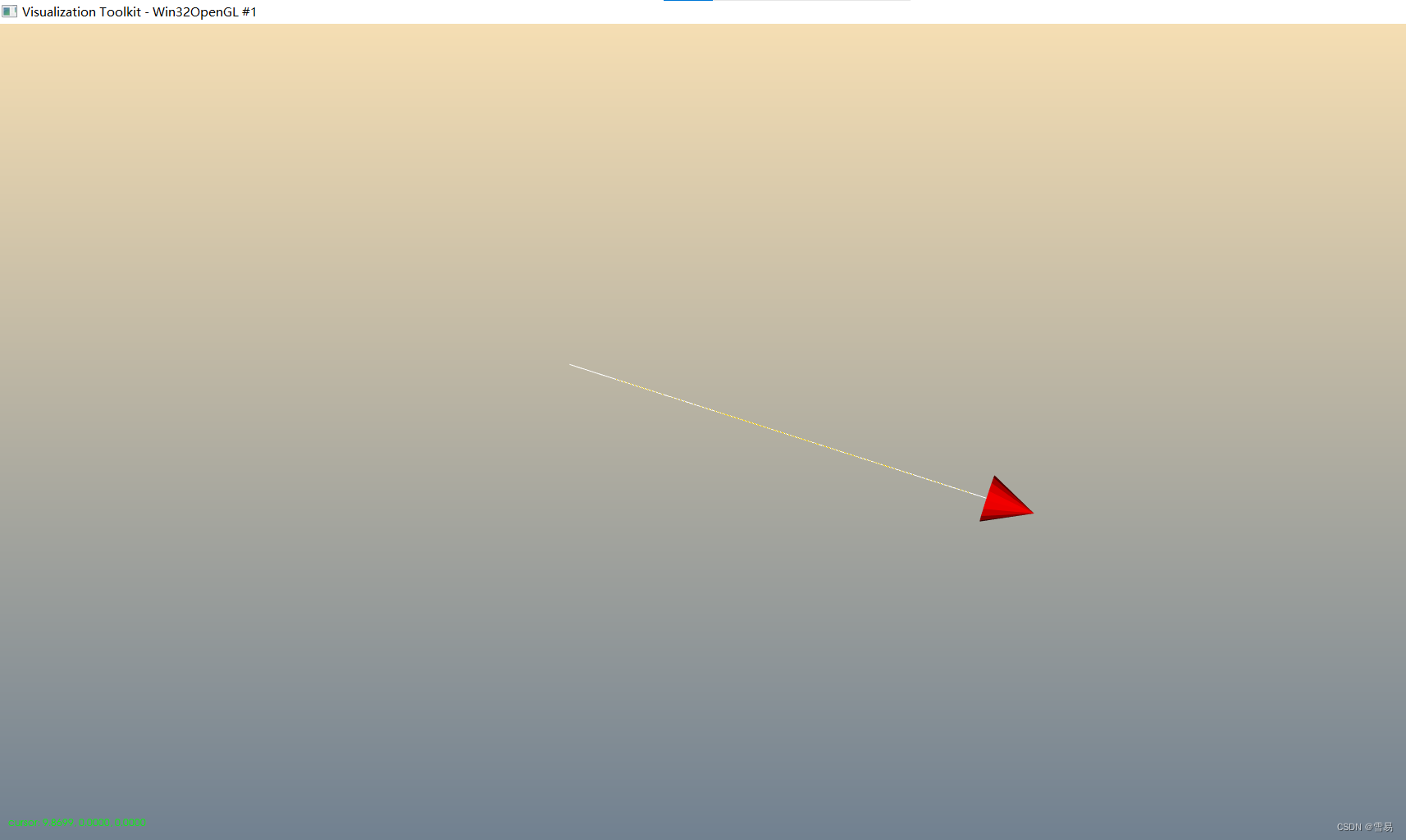【VTKExamples::Visualization】第一期 Arbitrary3DCursor
2024-01-07 21:37:19
很高兴在雪易的CSDN遇见你?
VTK技术爱好者 QQ:870202403
前言
本文分享Example中Visualization模块中的Arbitrary3DCursor样例,主要解析vtkProbefileter,希望对各位小伙伴有所帮助!
感谢各位小伙伴的点赞+关注,小易会继续努力分享,一起进步!
你的点赞就是我的动力(^U^)ノ~YO
1. vtkProbeFilter
? ? ? ? ?在指定的点位置采样数据值。
????????vtkProbeFilter是一个过滤器,在指定的点位置计算点属性(例如,标量,向量等)。过滤器有两个输入: Input和Source。输入的几何结构通过过滤器。输入点位置的Point属性通过插值到Source数据。例如:我们可以通过Volume(Source数据)计算平面上的数据值(平面指定为输入)。Source数据中的Cell数据根据每个输入点所在的源单元格复制到输出。如果在源的点数据和单元数据中都存在同名的数组,则只探测来自点数据的数组。
????????此过滤器可用于重新采样数据,或将一个数据集表单转换为另一个数据集表单。例如,一个非结构化网格(vtkUnstructuredGrid)可以用一个体(三维vtkImageData)来探测,然后体渲染技术可以用来可视化结果。另一个例子:一条线或曲线可以用来探测数据,从而沿着这条线或曲线生成x-y图。
2. 应用示例


 ??
??
 ?
?
// This does the actual work: updates the probe.
// Callback for the interaction
class vtkmyPWCallback : public vtkCommand
{
public:
vtkmyPWCallback() = default;
static vtkmyPWCallback* New()
{
return new vtkmyPWCallback;
}
virtual void Execute(vtkObject* caller, unsigned long, void*)
{
vtkPointWidget* pointWidget = reinterpret_cast<vtkPointWidget*>(caller);
pointWidget->GetPolyData(this->PolyData);
double position[3];
pointWidget->GetPosition(position);
std::ostringstream text;
text << "cursor: " << std::fixed << std::setprecision(4) << position[0]
<< ", " << position[1] << ", " << position[2];
this->PositionActor->SetInput(text.str().c_str());
this->CursorActor->VisibilityOn();
}
vtkPolyData* PolyData = nullptr;
vtkActor* CursorActor = nullptr;
vtkTextActor* PositionActor = nullptr;
};
void QtWidgetsApplication1::on_arbitrary3DCursorAct_triggered()
{
vtkSmartPointer<vtkPolyData> inputPolyData;
auto line = vtkSmartPointer<vtkLineSource>::New();
line->SetResolution(2);
line->SetPoint1(0., 0., 0.);
line->SetPoint2(10, 0, 0);
line->Update();
inputPolyData = line->GetOutput();
/*auto plane = vtkSmartPointer<vtkPlaneSource>::New();
plane->Update();
inputPolyData = plane->GetOutput();*/
/*auto sphereSource =
vtkSmartPointer<vtkSphereSource>::New();
sphereSource->SetPhiResolution(15);
sphereSource->SetThetaResolution(15);
sphereSource->Update();
inputPolyData = sphereSource->GetOutput();*/
auto colors =
vtkSmartPointer<vtkNamedColors>::New();
auto point =
vtkSmartPointer<vtkPolyData>::New();
auto probe =
vtkSmartPointer<vtkProbeFilter>::New();
probe->SetInputData(point);
probe->SetSourceData(inputPolyData);
// create glyph
auto cone =
vtkSmartPointer<vtkConeSource>::New();
cone->SetResolution(16);
auto glyph =
vtkSmartPointer<vtkGlyph3D>::New();
glyph->SetInputConnection(probe->GetOutputPort());
glyph->SetSourceConnection(cone->GetOutputPort());
glyph->SetVectorModeToUseVector();
glyph->SetScaleModeToDataScalingOff();
glyph->SetScaleFactor(inputPolyData->GetLength() * 0.1);
auto glyphMapper =
vtkSmartPointer<vtkPolyDataMapper>::New();
glyphMapper->SetInputConnection(glyph->GetOutputPort());
auto glyphActor =
vtkSmartPointer<vtkActor>::New();
glyphActor->SetMapper(glyphMapper);
glyphActor->GetProperty()->SetColor(1.,0.,0.);
glyphActor->VisibilityOn();
auto mapper =
vtkSmartPointer<vtkPolyDataMapper>::New();
mapper->SetInputData(inputPolyData);
auto actor = vtkSmartPointer<vtkActor>::New();
actor->SetMapper(mapper);
actor->GetProperty()->SetRepresentationToWireframe();
actor->GetProperty()->SetColor(colors->GetColor3d("gold").GetData());
auto textActor =
vtkSmartPointer<vtkTextActor>::New();
textActor->GetTextProperty()->SetFontSize(12);
textActor->SetPosition(10, 20);
textActor->SetInput("cursor:");
textActor->GetTextProperty()->SetColor(0.,1.,0.);
// Create the RenderWindow, Render1er and both Actors
//
auto ren1 =
vtkSmartPointer<vtkRenderer>::New();
auto renWin =
vtkSmartPointer<vtkRenderWindow>::New();
renWin->AddRenderer(ren1);
auto iren =
vtkSmartPointer<vtkRenderWindowInteractor>::New();
iren->SetRenderWindow(renWin);
// The SetInteractor method is how 3D widgets are associated with the render
// window interactor. Internally, SetInteractor sets up a bunch of callbacks
// using the Command/Observer mechanism (AddObserver()).
auto myCallback =
vtkSmartPointer<vtkmyPWCallback>::New();
myCallback->PolyData = point;
myCallback->CursorActor = glyphActor;
myCallback->PositionActor = textActor;
// The point widget is used probe the dataset.
//
auto pointWidget =
vtkSmartPointer<vtkPointWidget>::New();
pointWidget->SetInteractor(iren);
pointWidget->SetInputData(inputPolyData);
pointWidget->AllOff();
pointWidget->PlaceWidget();
pointWidget->AddObserver(vtkCommand::InteractionEvent, myCallback);
ren1->AddActor(glyphActor);
ren1->AddActor(actor);
ren1->AddActor2D(textActor);
// Add the actors to the renderer, set the background and size
//
ren1->GradientBackgroundOn();
ren1->SetBackground(colors->GetColor3d("SlateGray").GetData());
ren1->SetBackground2(colors->GetColor3d("Wheat").GetData());
renWin->SetSize(300, 300);
renWin->Render();
pointWidget->On();
// render the image
//
iren->Initialize();
renWin->Render();
iren->Start();
}结论:
感谢各位小伙伴的点赞+关注,小易会继续努力分享,一起进步!
你的赞赏是我的最最最最大的动力(^U^)ノ~YO

文章来源:https://blog.csdn.net/qq_40041064/article/details/135442941
本文来自互联网用户投稿,该文观点仅代表作者本人,不代表本站立场。本站仅提供信息存储空间服务,不拥有所有权,不承担相关法律责任。 如若内容造成侵权/违法违规/事实不符,请联系我的编程经验分享网邮箱:veading@qq.com进行投诉反馈,一经查实,立即删除!
本文来自互联网用户投稿,该文观点仅代表作者本人,不代表本站立场。本站仅提供信息存储空间服务,不拥有所有权,不承担相关法律责任。 如若内容造成侵权/违法违规/事实不符,请联系我的编程经验分享网邮箱:veading@qq.com进行投诉反馈,一经查实,立即删除!